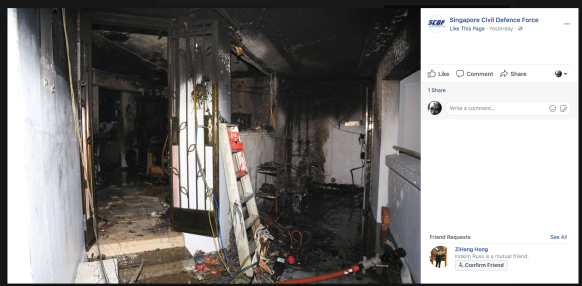Why Do E-Bike Batteries Explode?
An electric bike that was left charging overnight on Tuesday was just one of a string of recent ebike explosion incidents. In light of the growing popularity of electric mobility solutions in Singapore, Sgscooters felt a need to inform our users on the proper use and maintenance of lithium ion batteries that most e-bikes and e-scooters use.
However, this is NOT solely an electric bike problem. In 2017, there was a major recall of the Samsung Galaxy Note 7 triggered by exploding batter cells on flights. During the height of the hoverboard craze 2 years ago, houses caught fire from exploding hover boards that were left charging for long periods of time.
The question on many users’ minds will be, what can we do to prevent such a thing from happening to our electric bikes or electric scooters?

Screenshot from Singapore Civil Defence Facebook Page
Most E-Bikes and e-scooters these days use lithium ion batteries for their high charge density and lithium based batteries are volatile and come in many grades.
Causes of Overcharging
HEAT. Its the source of a lot of engineering problems in cars, phones, and electric bikes.
Higher grade lithium battery packs are relatively more stable in that they can withstand higher heat, higher pressure and have protection against overcharging.
Lower grade batteries are more volatile because the materials used within the batteries are lower quality hence do not insulate the volatile lithium components well.
When charging, heat is caused by the flow of current from the charger to the battery cell. When the charger is not equipped with overcharge protection, the current keeps flowing into the battery pack even when the battery is fully charged, causing even more heat.
Most packs are rated to work properly up to a temperature of 40 deg C. When the battery heats up beyond that temperature, the components inside the battery work unpredictably.
The insulation material inside the battery may not work properly beyond this point, hence causing a short circuit between the + and – terminals of the battery. And you know from primary school science that this is called a short-circuit. Bad things happen when a short circuit occurs.
Battery Quality
Always think twice when an electric bike with a Li-Ion battery pack seems to be too cheap. (We did an older article on why cheaper e-scooter and e-bikes are a safety issue here)
E-Bikes with a good quality Li Ion battery pack and a good quality charger will start at $600. Given that a good quality well-insulated 5.2Ah Li Ion battery pack (smallest sized battery for e-bikes) already costs about $250 to manufacture, an electric bike that costs below $800 would be fishy as batteries are about one third the price of the overall product.
The fish stinks even more when you consider the fact that all electric bikes in Singapore require an EN 15194 testing certification for it to be legally used. Most poor quality e-bikes with substandard battery packs skimp on materials quality, and have electronics with substandard components that will not withstand higher operating temperature conditions.
Charger Quality
The “smart” charging adaptors play an integral role in the whole power management of the e-bike. Good chargers have good fail-safe electronic design and components that will prevent overcharging of the batteries.
A possible cause of these overcharging batteries is that the over charge protection circuit fails in the low quality charging adaptors, causing the overcharging to occur.
In Singapore, power chargers here require an IEC test certificate to certify that the chargers are of good quality. The IEC test certificate is critical to obtaining the Spring Safety Mark approval.
How to Prevent E-Bike Explosions
When in the market for safe electric bikes, always consider the package as a whole including the company that sells it. Here are 3 ways to tell if the e-bike you are getting is considered safe for use:
Price
Although price is far from the best indication of quality, given our (limited) knowledge of manufacturing processes, it is fair to say that a good quality 36V 5.2Ah electric bike with the proper IEC and EN certifications for power safety should cost at least $800.
Avoid Overcharging
Most electric bikes with standard (non-mofidied) batteries will take 5-8 hours to charge. We do not encourage leaving the Li Ion batteries to charge beyond the 8 hour mark especially when the charging indicator indicates a fully charged battery. This applies not just to e-bikes but cell phones and laptop batteries too. Even without causing an explosion, overcharging will degrade the lifespan of the battery inside your electronic devices.
Safe Power Chargers
Power chargers being sold in the market will require an IEC certificate with a safety mark approval. Only good quality power chargers with proper overcharging protection design will have undergone and passed the IEC certification tests.
List of IEC Approved Electric Scooters with Safety Mark Chargers
- Inokim Quick
- Inokim Light
- I-MAX Q5
- I-MAX T3
- I-MAX S1+
- ZERO 2.0
- E-TWOW Booster Plus
- Ninebot Segway Mini Pro
